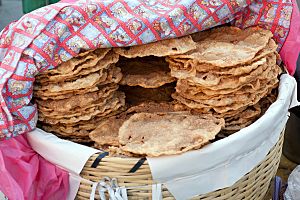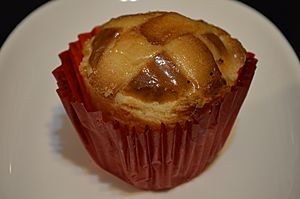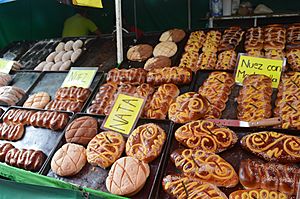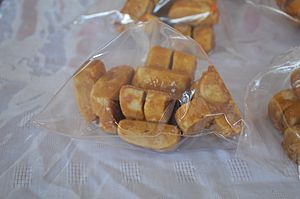Mexican breads facts for kids
Mexican breads and other baked goods have a rich history. They are a mix of different baking styles from Europe, especially France. Wheat and bread came to Mexico with the Spanish during the Conquest. Even though Mexicans eat more corn than wheat, bread is still a very important food for everyday meals and special events. Many of the hundreds of bread types made in Mexico were created right there. Mexicans usually buy their bread from bakeries or street vendors, rather than baking it at home.
Contents
Mexican Bakeries: A Sweet Tradition

Have you ever heard the saying "como pan caliente"? It means "like hot bread" and is used in Mexico to describe something very popular or in high demand! Wheat bread is super important in Mexico, second only to corn tortillas.
Mexicans usually don't bake their own bread. They buy it from local bakeries. White bread is often used for tortas (sandwiches) or as a side with big meals, like an alternative to tortillas. Sweet breads, called pan dulce, are popular for breakfast or a small evening meal called "merienda." This is usually between 6 and 8 PM, enjoyed with a hot drink like coffee or hot chocolate.
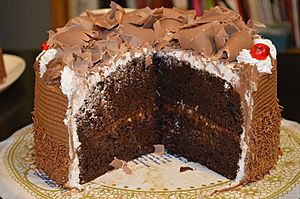
You might still see a traditional panadero (bread seller) riding a bicycle with a big basket of bread on his head! But most people buy bread from small family bakeries in their neighborhoods. It's often a family routine to send someone to the bakery for the freshest bread. The baking business is very stable in Mexico because bread is a basic need. However, bakeries sometimes struggle with rising costs and competition from supermarkets.
Mexican bakeries often specialize. Some are pastelerías (cake shops), and others are panaderías (white and sweet bread shops). But many bakeries make both. Making cakes is seen as a more skilled art. An average bakery might make about a hundred different kinds of breads throughout the year! The flour they use is similar to what was used long ago. Most bakeries use commercial yeast, but some bakers avoid preservatives to keep the taste pure.
Traditional Mexican bakeries still use old systems from the colonial period. Baking is a special trade that people learn by working with experienced bakers. It's like an apprenticeship! Bakers can move up as they learn more skills. However, men mostly do the baking, while women usually work at the front counter.
Inside a Mexican Bakery
The baking area is called the amasijo, which means "to knead." It's usually at the back of the shop. This area has tables, mixers, and a big oven built into a wall. These ovens can use gas or firewood. Older bakeries might even have ovens big enough to walk into!
Bakers start with a fermented mix of flour and yeast called madre (mother). Large mixers do most of the initial mixing. But for smaller batches, bakers still knead the dough by hand. The most experienced bakers, often the master baker or owner, make the fancy pastries. Different stages of bread making happen at the same time. You'll see dough rising and fresh breads cooling on racks. Cleaning is always happening to keep the bakery tidy.
When the breads are ready, workers move them to the front of the shop on big trays. In most bakeries, customers use round trays and tongs to pick their own breads. Then, they take their tray to a counter where a worker counts the breads and tells them the price. They pay at a separate cash register. Some bakeries have special refrigerated sections for cakes or pastries with cream or fruit fillings. It's also common to see a small shrine to a saint, like the Virgin of Guadalupe or San Judas Tadeo, near the counter.
Mexican baked goods are also popular in the United States, especially where many Mexicans live. In Los Angeles, there were only a few Mexican bakeries in the 1920s. Now there are many more! Also, a big Mexican company called Grupo Bimbo is one of the largest baking companies in the world. They sell Mexican breads in many countries.
Types of Mexican Breads
Amazing Variety
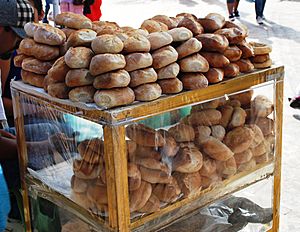
Mexico has a huge variety of breads, thanks to centuries of trying new things and influences from Europe. Most Mexican breads are special and connected to Mexico's history and culture. Mexico now has more types of bread than Spain, with estimates ranging from over 300 to more than 1000! Even small bakeries offer a wide selection.
Bakery Breads and Their Names
In the 20th century, some bread making became industrialized. Bimbo is a leader in this. This big company has bakeries in many cities around the world and exports some Mexican bread styles. But most traditional Mexican breads are still sold mainly in Mexico.
It's hard to count all the types of bread because their names can change from one region to another, or even from one bakery to the next! Some names are funny or playful. They come from Mexican culture, or describe the bread's shape. For example, corbata means "bow tie," violín means "violin," and ojo de buey means "ox eye" (a pastry shaped like an eye). Other names, like Chilindrinas, don't have a clear meaning. Some breads are named after historical figures, like Carlota, an empress from the 1800s. There are also breads named duque (duke) and polka. Some have common women's names like Carmela and Margarita, or names of other foods like taco or elote (corn).
Sometimes, bread names change when they move to new places. A twisted sweet bread called alamar in Mexico is sometimes called a "freeway" in Mexican communities in Los Angeles, because it looks like highway interchanges! In the United States, Mexican breads can get new names, sometimes in English, either by translating the name or comparing it to something similar. For example, dona is the Spanish word for "donut." Panque (from pound cake) often means individual pound cakes or cupcakes.
Generally, breads are grouped by the type of dough used. Some shapes, like roscas (rings) or cuernos (crescents), can be made with different doughs but have different names. Breads in the same group have a similar basic flavor but differ in shape or toppings. For instance, conchas, monjas, limas, chilidrinas, and negritos are all similar sweet breads, but their toppings make them look very different.
Many breads are known by their shape. Round breads that puff up naturally might be called volcanes (volcanoes) or almejas (clams). Others are made from strips of dough shaped like everyday objects, such as reja (grill), estribo (stirrup), puro (cigar), libro (book), ladrillo (brick), and lazo (rope).
There are many basic bread categories, including pan fino (fine bread), puff pastry (hojaldrado), cakes (pastel), cookies (galletas), and corn bread (pan de maiz).
The most common breads sold are still basic white breads for sandwiches and meals. These are made with simple flour dough, with just a little salt or sugar. Examples include españolas, bolos, pan de agua, bolillos, and teleras.
Sweet breads offer the most variety because of all the different flavors and fillings! Vanilla and cinnamon are key ingredients in many sweet breads. Other popular flavors include almonds, coconut, chocolate, orange peel, and fruit preserves like strawberry or pineapple. Some breads need to puff up a lot, so bakers use a finely ground mineral called tequesquite (saltpeter). This ingredient has been used since the 1700s! Most sweet breads are baked, but some are fried, often using beef or pork fat, or butter. The most famous fried breads are churros and buñuelos.
Special Breads for Celebrations
Many Mexican holidays and festivals have their own special breads and pastries. These can be sweet or white breads and are often served with drinks like atole (a warm corn-based drink) and hot chocolate. Breads made with picón dough, which is rich with eggs, milk, and cream, are common for celebrations like Easter Sunday. On other holidays like Christmas, Valentine's Day, Independence Day, and the Battle of Puebla anniversary, common breads and cakes are specially decorated.
One traditional festival bread is pan de pulque. As its name suggests, it's made with pulque, a fermented drink from the maguey plant. This bread is most popular in central and southern Mexico. It comes in different shapes and with various toppings. You can often find it sold by vendors with their own bakery trucks at town fairs. These breads are sometimes called pan de burro (donkey bread) because they used to be brought by vendors riding donkeys.

The rosca de reyes (king's ring) is a traditional sweet bread for Epiphany on January 6th. This ring-shaped bread, which came from Roman traditions, used to be filled with cream. In Mexico, it's usually decorated with ate (quince paste), raisins, and nuts. It's traditionally eaten with hot chocolate. Hidden inside the bread are small figures of the baby Jesus. Whoever finds a figure is responsible for providing tamales for Candlemas on February 2nd! This bread and tradition were brought to Mexico by the Spanish.

Pan de muerto (Bread of the Dead) is a very important bread for Day of the Dead. It's especially popular in states with many indigenous people, like Michoacán, Oaxaca, and Mexico City. For this holiday, bakeries make hundreds of these slightly sweet loaves. They are often placed on altars as offerings to loved ones who have passed away, and also eaten by the living. Most pan de muerto are round with criss-cross dough on top, representing bones. But there are unique versions, like those made with puff pastry, or shaped like sheep, hearts, hands, or even decorated wheels. In Oaxaca, some breads for this day are decorated with small painted heads made from flour and water. In Hidalgo, some elements are colored red, showing influence from ancient traditions where red was linked to death.
Regional Bread Specialties
Mexican breads also differ by region. Some local specialties include ladrillos in Aguascalientes; mestizas and pan de mujer in Sinaloa; coricos in Sonora and Sinaloa; coyotas in Sonora; semas in Durango and Coahuila; muéganos in Huamantla and Tehuacán, Puebla; cocoles and cheese-filled bread in Perote, Veracruz; pan de yema in Oaxaca; turcos in Nuevo León; aguacatas in Michoacán; fragiles and doradas campechanas in Santa María del Río, SLP; and picones de huevos in Lagos de Moreno, Jalisco.
Certain towns are famous for their excellent baked goods. These include Tingüindín, Michoacán; Acámbaro, Guanajuato; Chilapa de Álvarez, Guerrero; and San Juan Huactzinco, Tlaxcala.
The History of Baking in Mexico
Colonial Times: When Bread First Arrived
Before the Spanish conquest of the Aztec Empire, people in Mexico didn't have baked goods like we know them today. Their main grain was corn, used to make tortillas (flatbreads) and tamales (steamed corn dough). They also used amaranth to make shapes with maguey sap.
Wheat and baking came with the Spanish conquerors. Wheat was important because it was needed for communion wafers in churches. The first wheat was planted on land owned by Hernán Cortés. He later gave it to Juan Garrido, a freed slave who became one of the first bakers. The first bakeries opened in the 1520s. In Europe, baking was often a family business, but the Spanish didn't want to do manual labor. So, they taught the native people how to bake. This is why Mexicans usually bought bread from bakeries, instead of baking it at home.
At first, not many people bought bread because it wasn't very good, and native people weren't used to it. But as the quality improved and more Spanish and mixed-race people lived in Mexico, the demand for bread grew. Even though corn was still eaten more, bread became a very important food. Since only bakeries made bread, they became important businesses.
During the colonial period, bakeries were very strictly controlled. Hernán Cortés himself gave out the first licenses for grinding wheat. To keep prices low, authorities decided how much wheat could be used, how much breads should weigh, and how much they could be sold for. Each bakery had to mark its products so they could be identified. All businesses had to report their sales and purchases to the government. These rules were meant to make sure everyone had cheap bread and to stop people from unfairly raising prices. However, these rules didn't always work well because of corruption.
Baking became a special trade, and bakers formed guilds. Guild members had special rights, like selling bread to the upper classes. Only people of Spanish descent could be guild members. Even if indigenous women learned to bake in convents and sold bread, they could be punished. Being a guild member was a high status, but the actual baking work was done by employees who couldn't advance.
Until the early 1900s, life for bakery workers was very hard. Kneading dough was tough work, and shifts were 14 to 18 hours long. Poor ventilation and dirty conditions made bakers sick. Spanish owners often exploited workers, trapping them with debt or using forced labor from convicts. By the 1700s, most bakers were indigenous, mulatto, or mestizo.
Over time, bread became more popular, especially for breakfast. In colonial times, eating sweet bread with hot chocolate for breakfast became fashionable. By the late 1600s, there were hundreds of bakeries in Mexico's main cities. Bread was sold at bakeries, grocery stores, markets, and by wandering vendors.
Mexico's wide variety of breads also started in colonial times. Different bread styles appeared for different social classes. The best, whitest breads, called pan floreado, were for the rich. Poorer people ate pambazo, made with darker flour. Today, pambazo refers to a type of street food. French influence also began then, leading to breads like the bolillo (similar to a French roll). Monasteries and convents also created new recipes for breads like buñueles and empanadas, which are still made today.
Even though the first breads were simple, bakeries specializing in sweet breads, called bizcocherías, existed as early as 1554. By the late 1700s, most bakeries had people making sweet breads, and more varieties appeared, especially in cafés made popular by Italian immigrants in Mexico City.
1800s: Changes and New Influences
After the Mexican War of Independence, the rules for bakeries were relaxed. People hoped this would improve working conditions. But it didn't really work because bread prices still needed to be kept low for everyone.
The political situation was unstable, and many rich families didn't want to be in the baking business. So, bakeries changed owners often. In the mid-to-late 1800s, people from Europe, like the French, Italians, Austrians, and Basques, started opening bakeries. They brought new ideas and increased the number of bakeries. For example, the El Globo bakery chain in Mexico City was started by an Italian family in 1884. During the time of Porfirio Díaz, French breads and pastries were especially popular in Mexico City cafés. Also, U.S. style sandwich bread was introduced during the Mexican–American War. While new styles came in, these new owners often kept the old ways of employing workers.
These new owners greatly increased the number of bakeries, making it easier for many people to buy bread close to home. Before this, most people bought bread from street vendors. By 1880, Mexico City had 78 bakeries, plus many indigenous people selling their own breads. By the 1900s, some bakeries, like La Vasconia, became very famous.
Working conditions didn't change much for most of this century. But a big strike in 1895 helped end the practice of keeping bakery workers locked in dorms when they weren't working.
1900s to Today: Modern Baking
Even though bakers could leave the bakeries after their shifts by the early 1900s, they still worked 14 to 18 hours a day. Day of the Dead was one of the few holidays they had off. Many bakeries were owned by foreigners, especially Basques in Mexico City, which ate the most bread.
The Mexican Revolution brought big changes to the baking industry. It disrupted the food supply, especially in Mexico City. The revolution also led to workers fighting for their rights. Bakers joined the larger labor movement. But it was hard for them to get better conditions because the government needed to keep bread cheap for everyone. Bakery owners resisted workers' demands until 1928.
In the mid-1900s, new ways of making and selling bread appeared. Mechanical kneaders and mixers were introduced. Before the 1940s, most bakeries kept their breads in glass cases, and customers had to ask a worker to get their order. In the 1950s, a baker named Antonio Ordóñez Ríos changed this. He removed the glass, letting customers pick their own breads with trays and tongs. Then, a staff member would count the breads and calculate the price. This is the system used in most Mexican bakeries today!
Since the mid-1950s, the variety of breads has decreased a little. But neighborhood bakeries are still very popular, and most of them make their own products. Bakeries still provide many jobs for Mexicans. Basic white breads like bolillos and teleras are still staples, making up about 85% of all bread sales.
Mexican baking traditions have spread throughout history and continue to grow. When Mexican workers move to the United States, they often open Mexican-style bakeries there. Also, Grupo Bimbo, a company from Mexico City, has bought many baking companies around the world, becoming the largest producer of baked goods globally!
See also
 In Spanish: Panadería de México para niños
In Spanish: Panadería de México para niños



